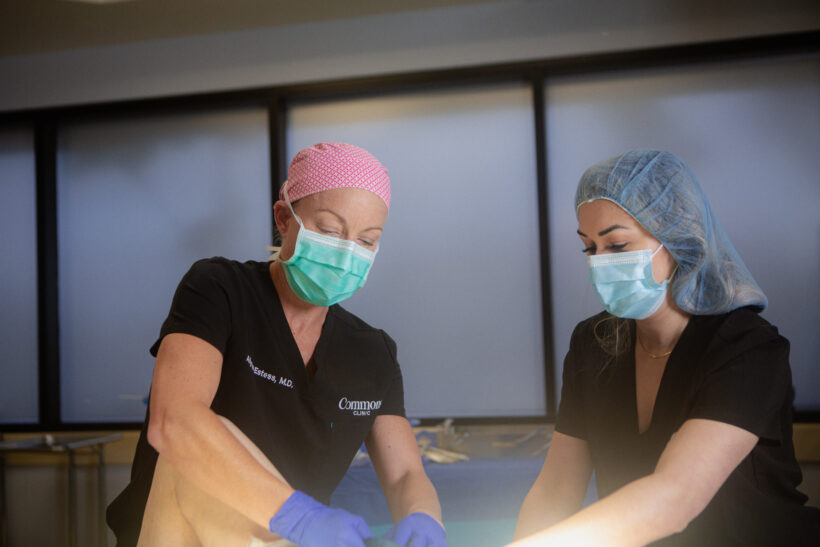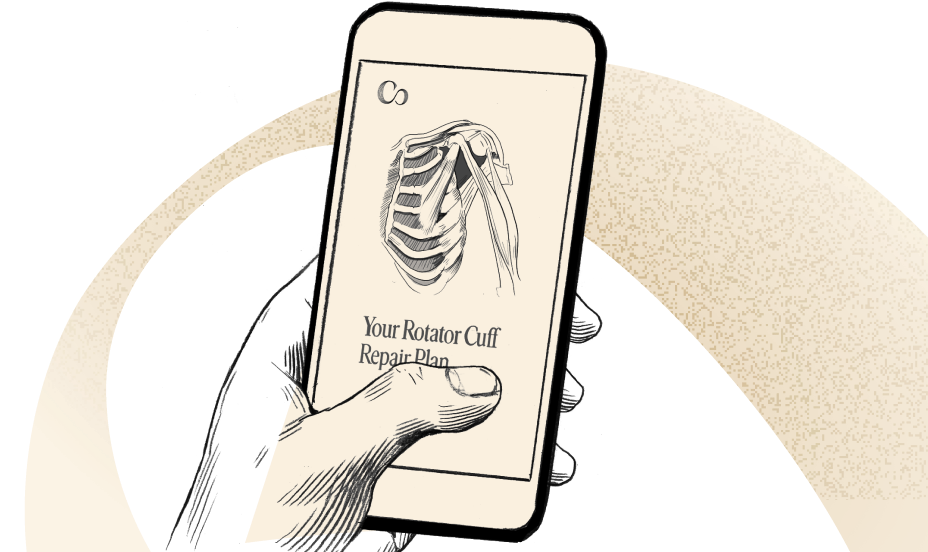Guide to Biceps Tendon Repair: Causes, Symptoms, and Surgery
Biceps tendon repair can restore the range of movement in your arm and ease pain from a tendon tear. Learn more about diagnosing a torn biceps tendon and treating the injury.
If you’re experiencing pain in your arm, you may have a torn biceps tendon. The tendon attaches your biceps muscle to the shoulder and the elbow — and the tendon can tear at either spot. A biceps tendon tear can cause pain, impair your range of motion, and impact your quality of life.
Though there are nonsurgical treatments that may help a partially torn tendon, the best way to restore a completely severed tendon may be through biceps tendon repair surgery. Your choice to have surgery will depend on a number of factors, including the location of the tear. (Biceps tendon tears at the elbow more commonly require surgery than those at the shoulder where the tendon has two attachments.)1
In this article, we’ll discuss torn biceps tendon injuries. “Distal biceps tendon rupture” refers specifically to those that occur at the elbow. Those that occur at the shoulder are called “proximal biceps tendon ruptures.” We’ll also look at what can cause a tendon tear, how your doctor can diagnose your injury, what treatments are available and provide an in-depth look at surgical options so you can make the best decision for your injury.
Understanding Biceps Tendon Tears
The biceps muscle, which runs along the front of your upper arm, is supported by tendons that attach to the bones of the shoulder and elbow. These tendons, or fibrous tissue cords, can tear at the elbow or the shoulder partially or completely.
The tendon at the elbow—the distal biceps tendon—attaches to a part of the radius bone called the radial tuberosity, which is near your elbow joint. The long head and short head tendons are bicep tendons attached to the shoulder. Once the tendon is totally torn, a biceps tendon will not grow back and reattach to the bone. 2
When there’s a tendon tear at the elbow, you may not be able to bend the elbow normally and have difficulty with certain rotations and movements. Because there’s only one place where the biceps tendon attaches at the elbow, losing that connection may have a more profound impact on your mobility.
A tendon tear at the shoulder may not require surgery because there are two tendons that attach at your shoulder joint (as opposed to only one tendon at the elbow). Most shoulder biceps tendon tears only impact one tendon. That said, you can tear only one spot at the shoulder and still feel weakness or pain in your arm. This injury may make it difficult to turn your palm up and down.
A biceps tendon can tear partially or be completely severed. A physician or surgeon will determine if you require surgery.

Causes and Risk Factors
The causes and risk factors for biceps tears vary based on the location of the tear or the extent of the injury.
Elbow tendon tears
The main cause of a biceps tendon tear at the elbow is a sudden injury, like from playing a sport. An injury can occur if your arm is extended and your elbow is straight when it encounters resistance. For instance, if you are lifting something and the weight of the item forces your elbow out of the bent position, you can risk tearing the biceps tendon. It’s less common to injure the elbow when it’s bent.
Men who are 30 and up are more prone to this injury compared to younger people and women. Smoking can increase the risk for a torn elbow tendon, as nicotine can make the tendon weaker. Taking corticosteroid and anabolic steroid medications can also increase your risk for a tendon tear.
Shoulder tendon tears
Biceps tendon tears at the shoulder can result from an injury, but are also commonly caused by overuse (such as playing a sport or doing an activity repetitively).
Older people are more vulnerable for shoulder biceps tendon tears because they’ve experienced more wear and tear on their bodies. If you regularly lift heavy weights, you’re equally as prone for a tendon tear. Repetitive sports like swimming and tennis can increase the risk. Smoking or taking corticosteroids can also raise your chances for this type of tendon tear.
Symptoms of a Biceps Tendon Tear
Symptoms of a torn biceps tendon may vary based on where the tear is or whether the tear is partial or complete. Symptoms of a tear or rupture can include:
- Pain
- Weakness
- Swelling
- Bruising
- A popping sound at the injury site
- Difficulty twisting the forearm or the entire arm
- A bulge in the muscle or gap near where the tendon used to attach
Diagnosing a Distal Biceps Tendon Rupture
Receiving an accurate diagnosis is the first step to receiving proper treatment. The board-certified orthopedic surgeons at Commons Clinic make sure you understand the full extent of your injury and can choose from a variety of applicable treatments. Depending on where the pain is, you can see an orthopedic surgeon who specializes in elbow surgery, shoulder surgery, or both.
During your appointment, your physician will ask about your medical history and symptoms. If you know exactly when or how the injury happened, they’ll want details. Next, your physician will visually examine the area. They may feel around the elbow or shoulder area to see if they can feel any part of the tendon intact. The surgeon will gauge your range of motion and strength, comparing the injured arm to your non injured one.
Imaging tests can help the surgeon confirm your diagnosis or give them more insights needed prior to surgery. They can also reveal any other elbow or shoulder injuries. The physician may recommend an X-ray to rule out any other problems that may be causing your pain or movement impairments. They may order an ultrasound of the torn tendon to view the soft tissue. An MRI also lets the orthopedic surgeon view soft tissue in the arm and confirm if you have a partial or complete tear in your biceps tendon.
Biceps Tendon Repair Surgery Options
Ideally, a distal biceps tendon repair surgery should be performed within two to three weeks after the initial injury to avoid the tendon scarring and shortening. If it’s too short, your physician may not be able to reattach the tendon. In that case, other surgical options are available, but they are more complicated and may not be as successful in terms of long-term recovery.
Your surgeon may recommend a biceps tenotomy for a proximal biceps tendon tear. This is a surgical procedure that involves completely severing the tendon, which can alleviate pain. Your biceps muscle will move further down in your arm without the tendon to support it.
“[Proximal tendon tears] are routinely performed arthroscopically, although some surgeons still perform an open tenodesis,” said Sarav Shah, MD, a double board-certified orthopedic sports and shoulder/elbow surgeon at New England Baptist Hospital in Boston, Massachusetts.
“For most people, pain from a biceps tendon tear can dissipate over time. Mild arm weakness or arm muscle deformity do not typically bother most patients pain wise but can have some residual cramping and fatigue. Many patients are able to return to their activities and sedentary jobs without limitations,” Shah added. Of course, if that doesn’t work for you, surgery may be a better option.
Shah said that nonsurgical management is an option for proximal tendon tears that make up less than 50 percent of incidences when the tendon attaches to the bone or in individuals that are not fit for surgical management.
Your surgeon will determine if this is a good option for you based on how you feel about the appearance of your arm after surgery, how quickly you want to recover, and other factors.
Shah says people who opt for a conservative approach (not undergoing surgery or waiting to see if function and pain are tolerable) to biceps tendon rupture need to be informed about the outcomes. These include an up to 50 percent loss of sustained supination (upward rotation) strength, an up to 40 percent loss of supination strength in general, an up to 30 percent loss of flexion (bending) strength, and an approximately 15 percent loss of grip strength, Shah adds.
Some people don’t opt for traditional surgery if they’re older or less active, if they are comfortable with the lack of full function, if they are at risk for other complications due to a surgery, or if they don’t have time to rehab the injury after surgery. A physician should have thorough discussions with you about your best options.

Preparing for Surgery
If your surgeon determines biceps tendon repair surgery is the best option, they’ll help you prepare for the operation.
The doctor may recommend local anesthesia (you are awake, but the surgical area is numb), regional anesthesia (you’re awake, but the surgical area and areas around it are numb), or general anesthesia (you’re asleep and pain-free).3
Your orthopedic surgeon should have a set protocol to ensure your pre-operative care, day of surgery, and recovery run smoothly.
Your care team will inform you of any preoperative testing you may need, if you need to fast the day before surgery, or what forms you’ll need to complete before the procedure. They’ll also inform you of what you’ll need to bring with you the day of surgery and can assist you in arranging for rehabilitation and post-operative care.
The Biceps Tendon Tear Surgical Process
There are different methods to attach the distal biceps tendon to the elbow area or the short- and long-head tendons back to the shoulder. Surgeons determine which method is best based on the severity of the tear.
If the tear occurs at the elbow, your surgeon may make a single incision at the front or inside of the elbow. Other surgeons also make incisions at the front and back of the elbow to perform the surgery.
During one method for tears at the elbow, the surgeon will cut into the skin and drill holes in the radius bone. Then, they will attach the tendon to it. The surgeon can also attach the tendon to the bone using suture anchors, which are metal implants.
If the tear is near your shoulder, doctors rarely reattach the torn tendon to the top of the socket (glenoid) and instead reattach it to the arm bone, or humerus. The surgeon may make a few incisions in your arm and attach it to the humerus with surgical screws. This can be done arthroscopically.
Regardless of the surgical method used, your surgeon will carefully repair any surrounding tissue damage and ensure the tendon is securely reattached. They will then close the incision with sutures, and the surgical site will be bandaged to protect it during initial healing.

Recovery and Rehabilitation
The care and attention you give to your arm after surgery can play a big role in your recovery and future function. Full recovery typically takes four to six months, though some patients may need up to a year to return to all activities, especially for overhead movements or heavy lifting. Most patients go home the same day as surgery, though some may stay overnight for observation.
Typically, you can return to desk work or very light activities within two to three weeks after surgery, though this varies by patient and type of repair. No heavy lifting or rigorous activity is permitted during this initial period. Listening to your body is key during this time to ensure you don’t overdo it.
After surgery, you’ll have to wear a splint and/or sling for about two weeks. For distal tears, you’ll need a hinged elbow brace for four weeks after that. The hinged brace allows for controlled movement of your elbow while protecting the repair, and your doctor will gradually increase your allowed range of motion during this time.
Your doctor will inform you when you should start physical therapy to get the area moving. Physical therapy typically begins two to six weeks after surgery, starting with gentle passive motion exercises. Most patients attend physical therapy two to three times per week for three to four months, with exercises to do at home between sessions.
This comprehensive rehabilitation process will help you regain your range of motion and build strength in the arm. The exercises are similar to those used to treat tennis elbow and other common elbow conditions, as the goal is to restore function while protecting the healing tissue.
Biceps Tendon Tear Complications and Alternatives
Every surgery can come with risks and complications. Though adverse events are rare, it’s good to be aware of what you may face after surgery.
You may experience numbness or weakness in your arm, including your wrist or hand, due to swelling around the nerves. This usually resolves in a few days to weeks, and physical therapy can help you regain strength in the affected area. However, you should contact your doctor if these symptoms persist or worsen. New bone may develop where the tendon is reattached (called heterotopic ossification), which can be part of the normal healing process. Sometimes, that growth can reduce your ability to rotate your forearm.
Other potential complications include infection at the surgical site, stiffness in the elbow or shoulder, decreased strength, and complex regional pain syndrome. In rare cases (about 1-2% of cases), the repaired tendon may re-tear, even after it fully heals. This is more common in patients who return to heavy lifting too quickly or don’t complete their rehabilitation program. While the initial surgery can improve muscle deformity that occurs with a rupture, a re-tear may cause this deformity to return.
Frequently Asked Questions (FAQs)
How long does it take to recover from biceps tendon repair?
That can vary based on your surgery, your medical status, if you utilize physical therapy, and other factors. Typically, you’re looking at a recovery time of anywhere from six weeks to a few months. A week or two after the procedure, you should be able to get back to light work. Your surgeon can give you a better idea of your timeline.
Is biceps tendon surgery worth it?
If your injury is interfering with your daily activities and quality of life, biceps tendon repair may be a smart idea. Your orthopedic surgeon will be able to tell you what to expect in terms of your prognosis.
How painful is a biceps tendon repair?
You’ll receive anesthesia during surgery, so you won’t feel any pain during the procedure. After surgery, you can expect moderate pain, particularly during the first 48-72 hours. Your surgeon will prescribe pain medication to help manage your discomfort during this initial period. After the first few days, you may be able to switch to over-the-counter pain medication. Applying ice packs for 20 minutes at a time, several times a day, can help reduce pain and swelling.4
Can a torn bicep tendon heal on its own?
If the tendon is partially severed but not completely unattached from the bone, it may be able to heal. If your doctor recommends nonsurgical options, these can include physical therapy, ice, medication, and rest.5
Conclusion
A biceps tendon tear may require surgical intervention such as a biceps tendon repair surgery, depending on the extent of the tear. However, this type of injury can also be treated non-surgically in many cases, especially proximal biceps tendon tears. The orthopedic care team at Commons Clinic can give you an accurate diagnosis to determine the right treatment plan that works for you. In addition to our world-class orthopedic surgeons that take you from diagnosis to surgery, Commons offers physical therapy to ensure you get the best possible results in the long term.
Sources
American Academy of Orthopedic Surgeons. Biceps Tendon Tear at the Elbow
American Academy of Orthopedic Surgeons. Biceps Tendon Tear at the Shoulder
Mount Sinai. Tendon repair
Oregon Health and Science University. Distal Biceps Tendon Repair Surgery Guide
UC Health. Biceps tendon ruptures or tears
Emory Healthcare: Biceps Tenodesis
Government of Alberta: Distal Biceps Tendon Repair: What to Expect at Home







 (310) 423-9834
(310) 423-9834